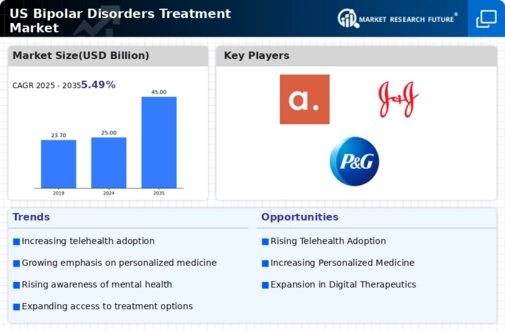Rising Prevalence of Bipolar Disorders
The increasing prevalence of bipolar disorders in the US is a critical driver for the bipolar disorders-treatment market. Recent estimates suggest that approximately 2.8 % of adults in the US experience bipolar disorder at some point in their lives. This growing patient population necessitates a corresponding rise in treatment options, thereby expanding the market. As awareness of mental health issues continues to grow, more individuals are seeking help, which further fuels demand for effective treatment solutions. The bipolar disorders-treatment market is likely to see a surge in both pharmacological and therapeutic interventions to cater to this expanding demographic. Consequently, healthcare providers are focusing on developing innovative treatment strategies to address the unique needs of this population, which may lead to increased investment in research and development within the bipolar disorders-treatment market.
Growing Demand for Personalized Medicine
The shift towards personalized medicine is becoming increasingly prominent within the bipolar disorders-treatment market. Patients are seeking treatment options that are tailored to their specific genetic, environmental, and lifestyle factors. This trend is prompting healthcare providers to adopt more individualized approaches to treatment, which may include pharmacogenomic testing to determine the most effective medications for each patient. As a result, the bipolar disorders-treatment market is likely to expand as providers develop and implement personalized treatment plans that enhance patient outcomes. Additionally, the focus on personalized medicine may lead to the development of new therapies that address the unique needs of diverse patient populations, further driving market growth and innovation.
Increased Investment in Mental Health Research
The bipolar disorders-treatment market is experiencing a surge in investment aimed at advancing mental health research. Government initiatives and private sector funding are increasingly directed towards understanding the complexities of bipolar disorders and developing novel treatment modalities. For instance, the National Institute of Mental Health (NIMH) has allocated substantial resources to research that explores the biological underpinnings of bipolar disorder, which may lead to more targeted therapies. This influx of funding is likely to accelerate the pace of innovation within the bipolar disorders-treatment market, resulting in the introduction of new pharmacological agents and therapeutic approaches. As research continues to unveil the intricacies of bipolar disorders, the market is expected to evolve, offering more effective and personalized treatment options for patients.
Technological Innovations in Treatment Delivery
Technological advancements are transforming the landscape of the bipolar disorders-treatment market. Innovations such as telemedicine and mobile health applications are enhancing access to care for patients. These technologies allow for remote consultations, medication management, and ongoing support, which are particularly beneficial for individuals who may face barriers to traditional in-person therapy. The integration of technology into treatment protocols is expected to improve patient adherence and outcomes, thereby driving market growth. Furthermore, the bipolar disorders-treatment market is witnessing the emergence of digital therapeutics that provide evidence-based interventions through interactive platforms. As these technologies gain traction, they are likely to attract investment and interest from both healthcare providers and patients, ultimately reshaping the treatment landscape for bipolar disorders.
Legislative Support for Mental Health Initiatives
Legislative measures aimed at improving mental health care access are playing a pivotal role in shaping the bipolar disorders-treatment market. Recent policies have focused on increasing funding for mental health services and reducing barriers to care, which is likely to enhance treatment availability for individuals with bipolar disorders. For example, the Mental Health Parity and Addiction Equity Act mandates that mental health services be covered by insurance plans at the same level as physical health services. This legislative support is expected to drive demand for treatment options within the bipolar disorders-treatment market, as more individuals gain access to necessary care. As these initiatives continue to evolve, they may further influence the landscape of mental health treatment, promoting a more supportive environment for those affected by bipolar disorders.














Leave a Comment